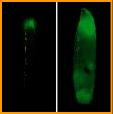




|
Research |

|
Metastasis, the spreading of cancer cells to different tissues, is clinically the most important process in the progression of most types of cancer, but it remains poorly understood at the molecular |
|
Research
|
|
Cancer models |
|
Models of cancer metastasis |

|
This work is funded by: |







|
Ventral nerve cord |
|
Optic lobe |
|
Eye disc |
|
Brain |
|
Home Research People Publications News Contact us |
|
In the larval metastasis model, clones of GFP-labelled cells in the developing eye expressing oncogenic Ras give rise to localised non-invasive tumours. Second site genetic alterations cause the development of metastatic behaviours characterised by migration, invasion and secondary tumour formation as visualised by the presence of GFP-marked cells in ectopic sites (in whole larvae top right and in dissected tissues above). We are using this powerful system to identify novel metastasis promoting or suppressing genes. |
|
Border cells are motile and invasive somatic cells in the Drosophila ovary that share some characteristics with human ovarian carcinoma cells. Border cells detach from their epithelial neighbours and migrate between the nurse cells towards the oocyte. Over the course of 6 hours they make their way to the oocyte-nurse-cell border, hence their name. Migration to the oocyte is guided by redundant PDGF/VEGF and EGF receptor signalling. Although this process is developmentally controlled, the migratory process shows a high degree of similarity to the events leading to the initiation of metastasis by cancer cells. Importantly, this process can be visualised in real time (see frames from time-lapse imaging above). Our goal is to use this system to elucidate the mechanisms by which metastasis promoting genes promote acquisition and maintenance of invasive characteristics. |
|
Larval metastasis model
Invasive border cell migration
|
|
level. The invasive process by which cancer cells move into surrounding tissues is well conserved in fruit flies and nearly all the genes implicated in human cancer metastasis are present in the Drosophila genome. We are using two models of metastasis in flies to determine the role of PP1-containing complexes in growth and spread of tumourous cells. Identification of the genes contributing to metastasis may help to improve our knowledge of the molecular pathogenesis underlying cancer progression and identify novel molecular targets for therapeutic intervention. Much interest surrounds the clinical introduction of specific protein kinase inhibitors. However, phosphatases represent 4% of the drugable human genome and may also provide novel targets for cancer therapy.
|
|
No metastasis Metastasis |

|
Cell signalling and Development in Drosophila |
|
Bennett Lab |
